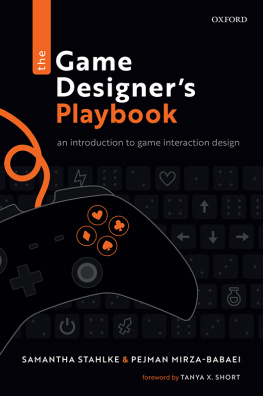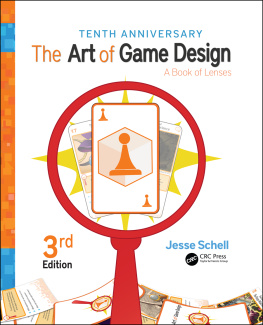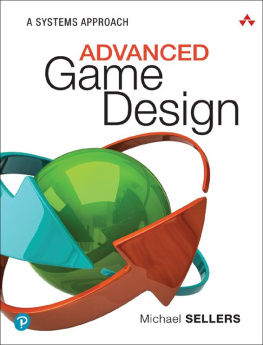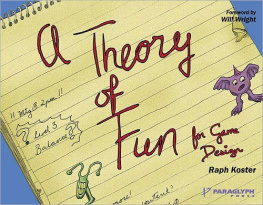This appendix contains a game design cheat sheet that synthesizes most of the most important development, user growth, and monetization lessons covered in this book. If youre unclear on any of these principles, be sure to read the chapter in which that principle was first featured and covered in detail. At the end of each of the following lessons, Ive included a cross-reference to the appropriate chapter.
Appendix C
Glossary of Terms and Acronyms
The appendix is a glossary of acronyms and game/tech industry terms frequently mentioned throughout the book. If youre a longtime gamer or game developer reading this, a lot of them will be painfully obvious; then again, other terms will seem alien or weird. Meanwhile, readers from the business development side of things will probably know many of them quite well, while wondering what the heck terms like physics puzzle and 2.5D are supposed to be. This appendix is for both kinds of readers.
2.5D game Game with graphics that appear to be 3D by using a constrained, isometric perspective. Backyard Monsters and other KIXEYE games mentioned in this book are 2.5D.
3D game Game that displays a first-person perspective or displays the game space with a camera view that rotates along the full X/Y/Z axis.
AAA game Big-budget game, generally for video-game consoles. This book is not about them, because they are a dying breed. Fewer and fewer will develop for themespecially low-budget indie folks.
accelerometer On the iOS, the feature that detects the phones position along the X/Y/Z axis.
acquisition cost The amount youll spend (such as on advertising) to get a new player to try your game.
A/B testing In game development, comparing user growth, engagement, and other behaviors to a feature change/addition, in relation to a control sample. Example: We gave a few thousand players a deadly garden gnome to use in the gladiator level, and ran an A/B test to see if they played longer.
acq-hired When a corporation buys a developers project or company for the purpose of owning its assets and turning the staff into its own employees.
advertising-based payments Form of revenue in which an advertiser offers virtual goods in a game in exchange for the user engaging with their product.
cloud deployment In gaming, broadband streaming of games directly to the end user, eliminating the need for long downloads or high-end hardware. OnLive and Gaikai are two leading cloud-deployment services.
ARPDAU Average revenue per daily active user.
ARPU Average revenue per user (as opposed to ARPDAU). Refers to the average revenue earned by a game per user on a monthly or yearly basis, or other designated timeframe.
asynchronous gaming Generally refers to multi-player games in which individual player movements are not conducted in real time, but are turn-based. Most Facebook games and many multiplayer iOS games are asynchronous. Most multiplayer web games are designed for real-time simultaneous play.
boss battle Final epic confrontation at the end of a game or game segment/level.
brand-to-player payment Revenue stream in which companies run ads in one game, offering virtual currency for other games.
consumables Limited-use virtual goods, such as potions, medicine, and so on.
conversion The process of turning a free player into a monetized one.
CPI Cost-per-installthe average amount you can expect to pay for advertising and other means to get a new player.
DAU Daily active user.
DAU/MAU The percentage of a Facebook games daily active users in relation to monthly active users. As an industry rule of thumb, a DAU/MAU rate of 20 percent or higher is extremely good.
DoD Dawn of Dragons (from 5th Planet Games).
D-pad Direction pad, the classic compass configuration used in old-school video-game consoles.
EA Electronic Arts, one the industrys largest publishers.
Facebook Credits Formerly the social networks official currency, once mandatory for use in all Facebook games, but discontinued in June 2012.
Facebook moms Somewhat patronizing way to describe women in their 30s, 40s, and 50s who generally make up the largest audience for social games, especially casual, social, and light simulations.
forced virality (aka friend gating) In Facebook games, requiring that players invite or otherwise engage with friends in order to access selected game content. See: every single game Zynga has ever made.
freemium Game based on assets associated with and based on an existing book, movie, TV show, game, or other IP. The freemium business model is also known as F2P, or free-to-play.
hard-core gamer Audience of gamers, typically young and male, who prefer action and detail-oriented strategy/combat/building games, usually with 3D graphics, and who tend to monetize at the highest rates. Steam, Xbox 360, and PS3 are the main hard-core gamer platforms, but mid-core games are also often popular with this segment.
HTML5 Latest 3D graphics and interaction-friendly version of markup language for web pages, designed to work with powerful multimedia and interactive features (i.e., gaming).
in-app offer Advertising offer displayed within a game, usually linked to a games virtual goods.
IAP In-app payment, generally referring to a micro-transaction conducted within an iOS game.
IP Intellectual property (such as game characters, storyline, or art assets).
launcher game Physics puzzle in which the object is to hit various objects by launching projectiles via catapult, cannon, and so on.
licensed/franchise properties Games based on assets associated with an existing book, movie, TV show, game, or other IP.
LTV Lifetime value of a given monetized player.
MAU Monthly active user. Rhymes with cow. Usage example: Did you know that the Facebook satire game called Cow Clicker actually attracted a lot of fans? Cow got good MAU!
mid-core Intended for an audience at the midpoint between casual and hard-core gamers. Sometimes this relates to platform availability. KIXEYE games, for example, are often called mid-core, because theyre games for hard-core players who cant bring their Xboxes to work.
MMO Massively multiplayer online game. Often used to describe iOS, web, or Facebook games that have persistent, shared gameplay elements, such as High Noon for the iOS, RuneScape for the Web, and Dragons of Atlantis on Facebook.
offer walls In these, gamers are given the opportunity to gain some kind of benefit (usually virtual goods and currency in the iOS game they play) if they install and launch a designated game at least once.
on-ramp Steps a new player must take to become a regular player, such as account creation and orientation.
physics puzzle game Game in which challenges are accomplished with the dynamic use of simulated gravity, inertia, and other Newtonian physics. Angry Birds, of course, is the killer physics puzzle game (also a launcher game).

![Wagner James Au [Wagner James Au] Game Design Secrets](/uploads/posts/book/119431/thumbs/wagner-james-au-wagner-james-au-game-design.jpg)





![Jesse Schell [Jesse Schell] - The Art of Game Design, 2nd Edition](/uploads/posts/book/119435/thumbs/jesse-schell-jesse-schell-the-art-of-game.jpg)
![Ethan Ham [Ethan Ham] - Tabletop Game Design for Video Game Designers](/uploads/posts/book/119417/thumbs/ethan-ham-ethan-ham-tabletop-game-design-for.jpg)


